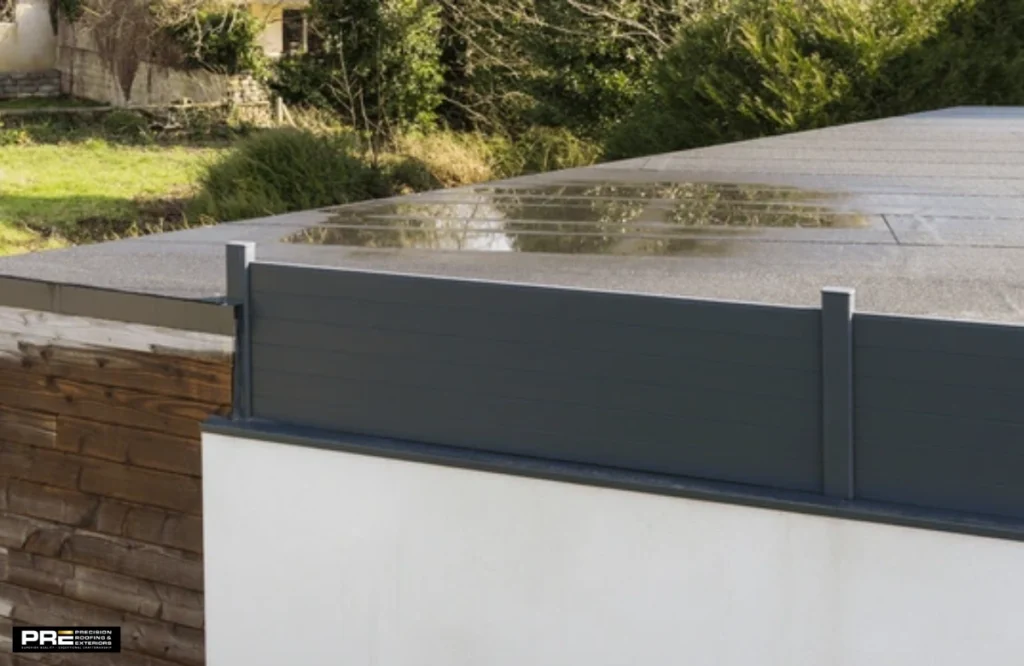Not every roof soars steeply overhead. Some stay almost flat, stretching wide across the top of a building with just a subtle tilt. That’s a low slope roof.
It’s not actually flat, though it may look that way at first glance. The pitch is shallow but intentional, designed to keep water moving instead of pooling. You’ll spot these roofs on warehouses, shopping centers, apartment buildings, and even some modern homes.
Why choose a low slope roof? The reasons vary. For some, it’s the cost. For others, it’s design flexibility. And in many cases, it’s simply practical: more space, easier access, potentially better energy performance. Let’s unpack what they are, the main types, and why property owners keep turning to them.
Understanding Low Slope Roofs
At its simplest, a low-slope roof is defined as having a pitch of 3:12 or less, with shingles not suitable below 2:12 and requiring special underlayment between 2:12 and 4:12. That means the roof rises three inches or less for every twelve inches of horizontal span. To most eyes, it looks flat, but without that slight rise, water wouldn’t drain.
Because of this shallow angle, shingles don’t cut it. They’re too vulnerable to leaks here. Instead, low slope systems rely on wide sheets or membranes that overlap minimally, leaving fewer gaps where water could sneak in.
These roofs have become a staple in commercial construction. They cover large areas without the cost and complexity of steep pitches. But they’re not just for factories and offices anymore. Sleek modern homes often use them too, adding to that streamlined, contemporary look many homeowners want today.
Low Slope Roofing Options
Low slope roofing usually comes down to three main options, each with its own role to play.
1. PVC Roofing
PVC is one of the veterans. It’s a plastic-based single-ply membrane rolled out in sheets, with seams heat-welded until they form watertight bonds. That welding makes PVC tough against leaks.
It’s not just strong, though. PVC handles chemical exposure better than most, which is why you’ll see it on restaurants and industrial buildings. And since lighter colors reflect heat, it’s a smart option for properties in warm climates.
2. EPDM Roofing
If PVC is the veteran, EPDM is the workhorse. This synthetic rubber roofing has been in use for decades, and it’s built to last. Large black rolls cover huge spans with very few seams, cutting down one of the weak spots every roof has.
EPDM is flexible, so it resists cracking in extreme heat or cold. And it’s affordable! For property owners balancing budget with durability, EPDM has long been the go-to option.
3. TPO Roofing
TPO is the newer kid on the block, but it’s made a big impression. Like PVC, it’s a single-ply membrane, also heat-welded at the seams. Its selling point? Balance.
It’s more affordable than PVC but offers similar energy-saving qualities thanks to its reflective surface. That’s why TPO has exploded in popularity over the last 20 years. It strikes a sweet spot between cost and performance that appeals to both commercial and residential customers.
Benefits of a Low Slope Roof
Choosing a roof is never just about covering a building. It is about how that choice will work year after year. Here’s what makes low-slope systems appealing:
- Lower upfront cost: Lower installed cost per square foot on large footprints due to simpler detailing and faster installs (final cost varies with insulation thickness and system type).
- Safer access for workers: Crews do not need to balance on sharp angles. Inspections, cleanings, and small fixes can be handled more comfortably, and that ease often translates into lower maintenance bills.
- Space that works harder: These roofs do not simply sit idle. They can hold HVAC equipment, support solar panels, or even create extra functional areas. The roof becomes part of the building’s utility, not just a cap.
- Materials built for endurance: Modern options such as PVC, EPDM, and TPO have been designed to last. They stand up to UV exposure, temperature swings, and moisture without wearing out too soon.
- Energy-conscious design: White PVC/TPO (or coated systems) reflect sunlight. On hot days, that difference is felt inside: cooler spaces, less strain on the air conditioner, and reduced energy use.
- A look that adapts: Some buildings call for industrial strength, others for sleek residential style. A low slope roof can do both, fitting a warehouse just as well as a modern home.
Conclusion
A low slope roof may appear simple, but the design is intentional: a shallow pitch that controls water, paired with membranes engineered to seal and protect. It is a system built for performance as much as practicality.
The benefits stretch from cost savings to energy efficiency, with durability and usable space in between. Some choose it for budget, others for style, and many for the flexibility it offers in both commercial and residential settings.
For any property owner weighing roofing options, a low slope deserves a closer look, and expert roofing contractor like Precision Roofing is ready to guide the way.

